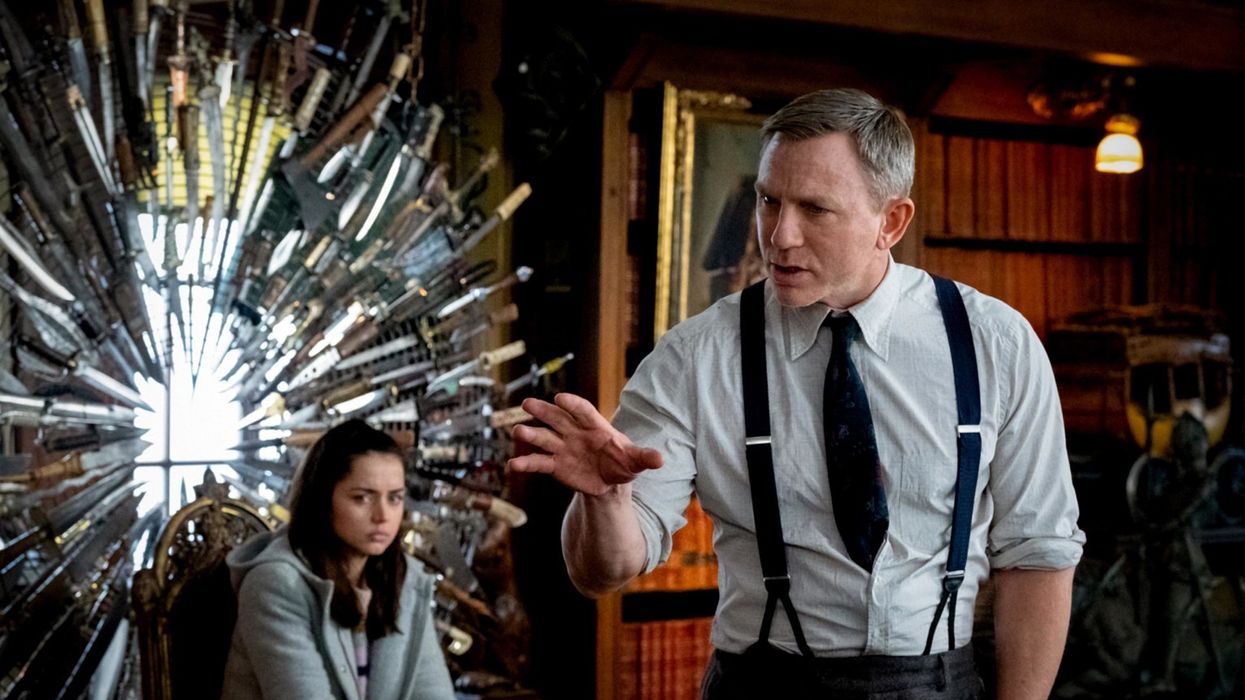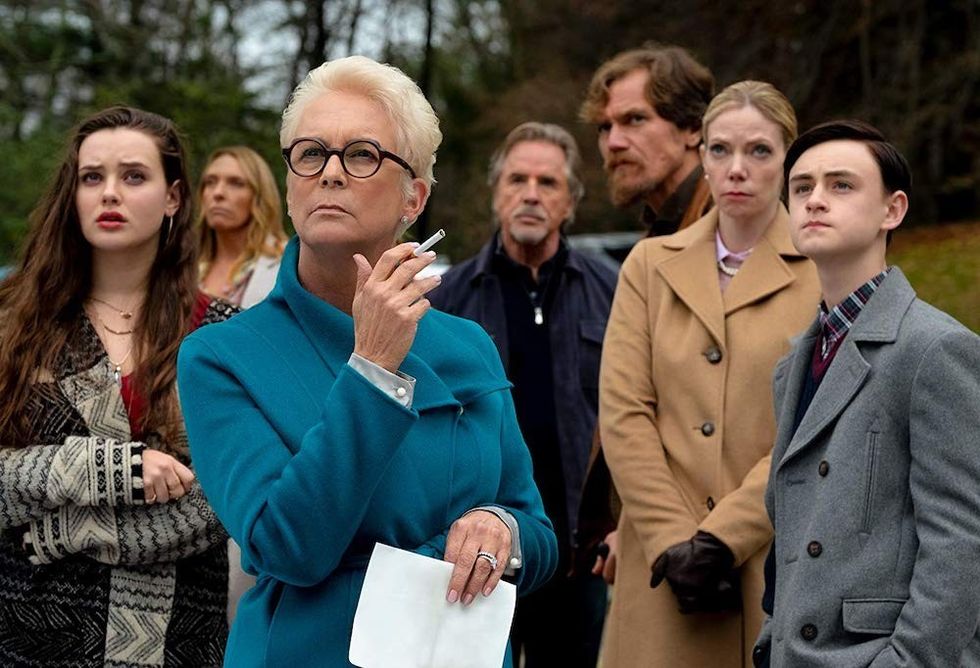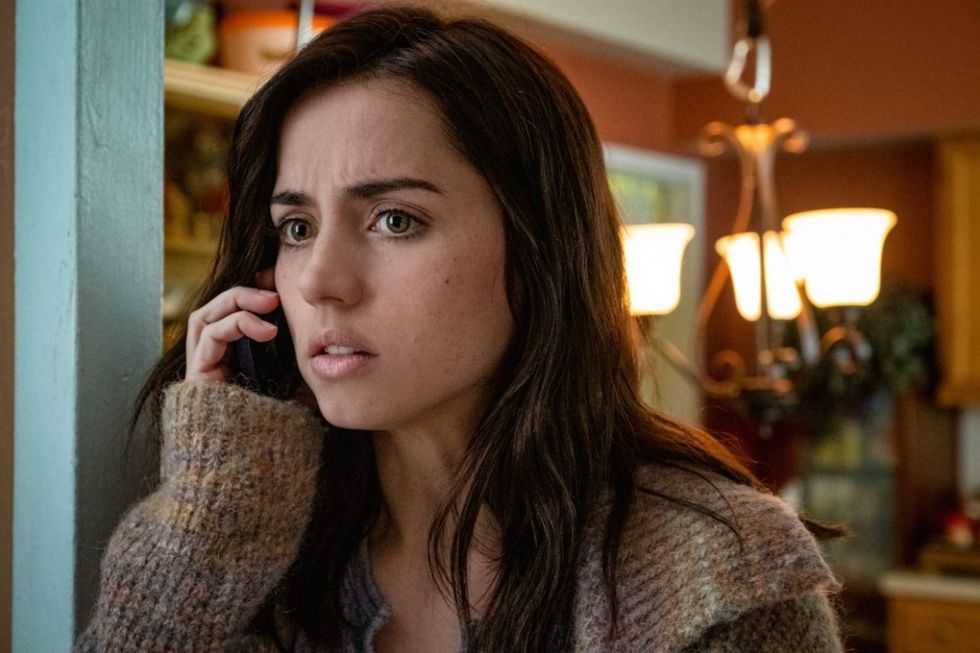Cut Through the 7 Layers of 'Knives Out'
Let's deconstruct director Rian Johnson's modern-day whodunit.

Rian Johnson’s film Knives Out kept audiences on their toes. From the all-star cast to the embedded clues that gave away the ending all along, this movie took everything you thought you knew about mysteries and turned it on its head. The detail that was sewn into every layer of this story was easy to miss the first time around (and perhaps the second and third, too). Let’s take a look at the surface.
This video from FilmJoy explains the multifaceted world of Knives Out. From its digital aesthetic to the subtle implications of each character's emotional reaction, this movie practically begs to be broken down and observed.
A Digital World
Director of photography Steven Yedlin was dubbed by this YouTuber as not only a camera nerd but the camera nerd. He thinks that it makes sense that filmmakers want to preserve the imperfections of a film camera; such as gate weave or luminance value. Through Yedlin’s work on Knives Out, he is proving that not only can you mimic the aesthetic of film digitally, but shooting on a digital camera has its own benefits. Specifically that you can better manipulate light to interact with the camera. The way he sets up light to be perceived by the sensor of the digital camera creates an entrancing aesthetic that makes every shot pop with color.
The aesthetic of a film is a role in and of itself. Yedlin has mastered the art of including a traditional look to a new age philosophy of camera work. In Knives Out, the aesthetic of the mansion is commanded by the light that enters through the windows and sometimes within. Presenting a setting for a murder mystery is no easy task. Johnson and Yedlin set up a world that was unsettling yet just warm enough that it was still somewhere that audiences wanted to be.
A Cast Apart
A fun way to describe the performances in this movie is as an “acting clinic.” Each individual performance was part of a giant puzzle. More on this later. However, to have a cast that involves Jamie Lee Curtis, Ana De Armas, Chris Evans, Daniel Craig, and so many more, is notable. There isn’t a clear explanation as to why this cast is so jam-packed with stars, but who’s complaining? Many people have called this movie one of the most fun watches of the 2010s.
Let’s be real, when a movie attaches too many big names to itself, it risks using that as a crutch. Knives Out was delightfully surprising in that the cast was almost in disguise the whole time. We might have been watching some of the biggest names in Hollywood interact with each other, but it still managed to feel authentic. But that also didn’t stop it from being bait for our dads watching it with us to say, “Hey, that’s the actor from ________!”
“Yarn”
Knives Out is clever. FilmJoy describes it as a film that “cooks for an hour on high.” Much like he did with The Last Jedi, he made Knives Out by deconstructing the flow of what a mystery traditionally looks like. He basically proved that there aren’t enough mystery thrillers loaded with mega-casts.
Johnson’s approach to this genre was praised and appreciated by many. The story’s surface is palatable, which makes it a great start to something much deeper. Falling down the rabbit hole after act one is the thrill of this film. Whether you like Rian Johnson or not, it’s hard to deny the genius of Knives Out.

Automata
An automaton is a human-like doll that performs the same function repeatedly. Harlan Thrombey (Christopher Plummer) collects them in his mansion, which adds to the unsettling feeling of the residence. The presence of these objects in the film is both an act of symbolism and homage. In 1972’s Sleuth, a murder mystery also takes place in a house that is filled with puzzles and automata. This is one of Rian Johnson’s favorite films. But in the vein of symbolism, these automata represent Harlans’ greedy children who, without the controller of the house alive, are lost and unable to live the lives they used to. The subtle references and messages used throughout this film are what make it more than just a murder thriller.
Artistry
All of Harlan’s kids claim they are self-made overachievers. They made themselves out to project strength and hide any ounce of weakness. We see it in the interrogation scenes. Their performative outrage is meant to deter the detectives from picking up on the real reason they’re interested in Harlan’s death—which is to see who gets the fortune. Furthermore, the little realizations such as Benoit (Daniel Craig) seeing the blood on Marta’s (Ana De Armas) shoes or Ransom (Chris Evans) realizing he may have gotten away with murder, are all part of the artistry.
Another piece of the puzzle is the many hidden clues. From the portrait of Harlan changing expressions from a grimace to a smirk when Marta takes the inheritance to every clock and phone being set to the correct time in the film so you can keep track of the events, this movie is said to “reward the audience for paying too close attention.” After all, it is also about the craft beyond the surprise...and if crafting this type of story is what you're after, take a piece of advice from Knives Out: let nothing go to waste and let everything be earned.
Reality
A very not-so-subtle part of this film is its raw reality. It’s a look at “a radical redistribution of wealth from a self-made empire to an immigrant caretaker with an undocumented parent.” When Benoit Blanc mostly solves the case on the first day, he realizes that solving the case is not necessarily synonymous with doing the right thing because he knows that puts Marta in danger. But our reality begs us to keep the status quo and allow things to stay exactly where they are. We want comfort. The Thrombey family wants comfort in knowing their lives won’t change once Harlan is gone. When their perceived reality is threatened by Marta, things don’t go over well.

Looking at Knives Out through the lens of socio-economic gain puts it all into perspective. Harlan knows his family is a bunch of entitled, self-righteous leeches. This is why his gesture of leaving everything for Marta isn’t some grand display of generosity as it is basic empathy.
Donut Hole
Ransom wasn’t the only one removed from Harlan’s will; the entire Thrombey family was. But Ransom was the first one to find out about it, making him the first one to have an opportunity to do something about it. Overall, any of the family members could have committed the crimes he did since they all would have the same motives (and not to mention tempers). Despite Ransom’s meddling, Marta did save Harlan. But short of that missing piece of the donut, he killed himself in an attempt to save her.
At the center of this story is Harlan and Benoit’s empathy toward Marta, who has everything to lose. The inheritance is left to her because Harlan knows it is rightfully hers. He spent his life trying to get his family to earn their place in the world by means of hard work instead of nepotism. After Marta proves herself to be a trustworthy and hardworking person, the millionaire believes it’s only right to give her what she’s earned.
The layers of Knives Out run deep. Rian Johnson’s take on the classic whodunit plot will stick with us for years to come.
What did you think about this film? Let us know in the comments.
Source: FilmJoy














